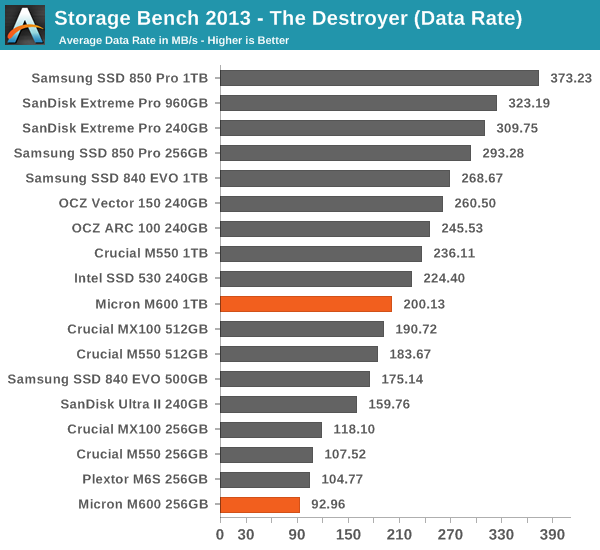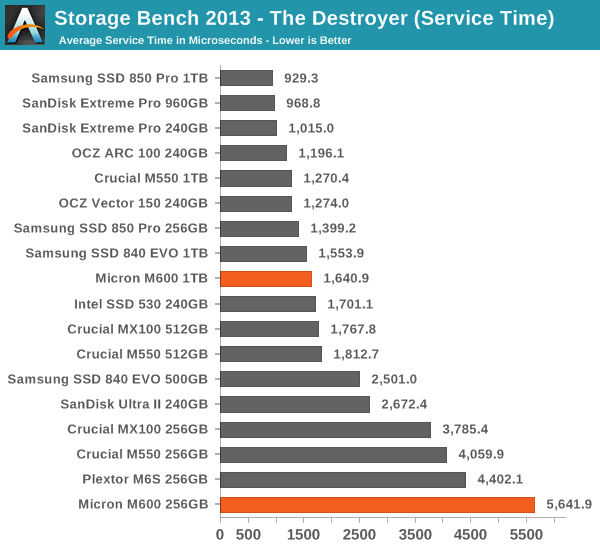Micron M600 (128GB, 256GB & 1TB) SSD Review
by Kristian Vättö on September 29, 2014 8:00 AM ESTAnandTech Storage Bench 2013
Our Storage Bench 2013 focuses on worst-case multitasking and IO consistency. Similar to our earlier Storage Benches, the test is still application trace based – we record all IO requests made to a test system and play them back on the drive we are testing and run statistical analysis on the drive's responses. There are 49.8 million IO operations in total with 1583.0GB of reads and 875.6GB of writes. I'm not including the full description of the test for better readability, so make sure to read our Storage Bench 2013 introduction for the full details.
| AnandTech Storage Bench 2013 - The Destroyer | ||
| Workload | Description | Applications Used |
| Photo Sync/Editing | Import images, edit, export | Adobe Photoshop CS6, Adobe Lightroom 4, Dropbox |
| Gaming | Download/install games, play games | Steam, Deus Ex, Skyrim, Starcraft 2, Bioshock Infinite |
| Virtualization | Run/manage VM, use general apps inside VM | VirtualBox |
| General Productivity | Browse the web, manage local email, copy files, encrypt/decrypt files, backup system, download content, virus/malware scan | Chrome, IE10, Outlook, Windows 8, AxCrypt, uTorrent, Ad-Aware |
| Video Playback | Copy and watch movies | Windows 8 |
| Application Development | Compile projects, check out code, download code samples | Visual Studio 2012 |
We are reporting two primary metrics with the Destroyer: average data rate in MB/s and average service time in microseconds. The former gives you an idea of the throughput of the drive during the time that it was running the test workload. This can be a very good indication of overall performance. What average data rate doesn't do a good job of is taking into account response time of very bursty (read: high queue depth) IO. By reporting average service time we heavily weigh latency for queued IOs. You'll note that this is a metric we have been reporting in our enterprise benchmarks for a while now. With the client tests maturing, the time was right for a little convergence.

Wow, this actually looks pretty bad. The 256GB M600 is slower than the 256GB MX100 and I guess it is due to the fact that under sustained workloads, the M600 will have to transfer data from SLC to MLC at the same time it is taking in host IOs, so the performance drops due to the internal IO overhead. The 1TB drive does better thanks to higher parallelism, but even then the M550 and 840 EVO are faster.











56 Comments
View All Comments
nirwander - Monday, September 29, 2014 - link
First 840 EVO, then MX100...hbarnwheeler - Monday, September 29, 2014 - link
What explains the data loss? Are you suggesting that DRAM was not being flushed during system suspension?milli - Monday, September 29, 2014 - link
Damn, I'm having four systems which are having suspend/resume issues. Especially when the system goes into S5 suspend. All four have MX100 drives. Two identical systems with other brand SSD have not such issues.I'm not having corruption but sometimes when the computer is resumed from S5, it can't find the drive.
Bought those drives based on Anand's recommendation. Thx
Thank you for the link. It will be helpful. Can you confirm that modifying hipm dipm helps?
metayoshi - Monday, September 29, 2014 - link
I wouldn't be so sure as to blame Micron for losing data or getting errors when it comes to Windows suspend and resume. I have had WD, Seagate, and the acquired Fujitsu, Hitachi, and Maxtor HDDs, and Intel, Crucial, and Corsair SSDs, and all of them have had problems when it came to Windows suspend and resume. I never ever use Windows' own Sleep and Hibernate states anymore because of this problem. These power states from Windows are not even supposed to be considered an unexpected power loss by most of these storage industry manufacturers because it is required by the specs for Windows to gracefully flush any cached data and power down the drive before yanking the power to it. As far as I know, all of these drives can handle a graceful power down just fine.Unexpected power loss should happen if and only if the user either physically holds down the power of their PC to forcefully shut down the system, or the power cable is physically disconnected from the drive during operation. If an error is happening during suspend and resume, there's usually something wrong that the OS is doing, or something wrong that the OEM system is doing because if there is no graceful power cycle to the storage during suspend and resume, that's the OS's or the OEM's or the BIOS's fault.
BedfordTim - Monday, September 29, 2014 - link
I always disable sleep for that very reason. With my Thinkpad and Vista it never woke, and while things have got better it still happened with Windows 7 on every machine I have tried it on.Lerianis - Friday, October 3, 2014 - link
O'really? On every single computer I have had, sleep worked without issues. I've had Gateway's, HP's, Acer's, Toshiba's, etc. None of them had problems with sleeping properly in Windows Vista - 8.1.I'm thinking that you are exaggerating or just out and out falsifying what actually was going on.
leexgx - Saturday, November 1, 2014 - link
i agree i always sleep my computer and laptops only OS that had a problem with doing it was Vista with Nvidia + creative card (witch was not comptelay VIsta fault) on windows 7 never had an issue with sleepi guessing i not had the issue with the 2 512GB MX100 i have (X58 i7-920 systems) as the motherboard i got due not support any of the adv power management features (well i did have to update the firmware in the other system as it was failing after 5 minutes but that system has always been odd, but the firmware update did seem to resolve it or something els i did)
leexgx - Saturday, November 1, 2014 - link
probably bad luck with Drivers and sleep (Drivers are what norm break the sleep, last time i had BSOD issues was related to Sleep and Creative sound drivers)not that i need to sleep this system as it boots up in under 20 seconds (but Chrome is compleatly CPU bound when it reopens 40 tabs)
Lerianis - Friday, October 3, 2014 - link
Is this problem/issue present with Windows 8? Or did they fix this issue?shodanshok - Monday, September 29, 2014 - link
Hi Kristian,it seems that Dynamic Write Acceleration is disabled on 512GB and 1 TB disks. From techreport:
"Surprisingly, the 1TB and 512GB variants don't have Dynamic Write Acceleration. Those drives are already fast enough for the controller, according to Micron, and the math works out. The Marvell chip can address up to four chips on each of its eight memory channels, making 32-die configurations ideal for peak performance. At 16GB per die, the cut-off point is 512GB."
This is probably the reason behind the 512 GB units having only 50% more endurance that the 256 GB one: DWA on the smaller one can absorb many writes and flush them in sequential form on the MLC array, saving some flash wear (in average).
Regards.